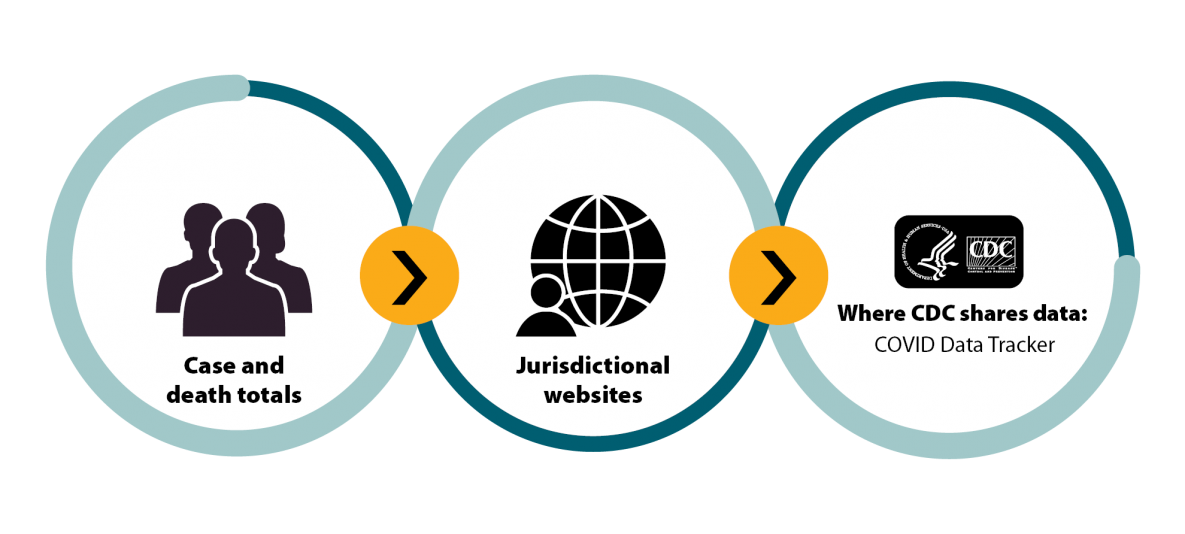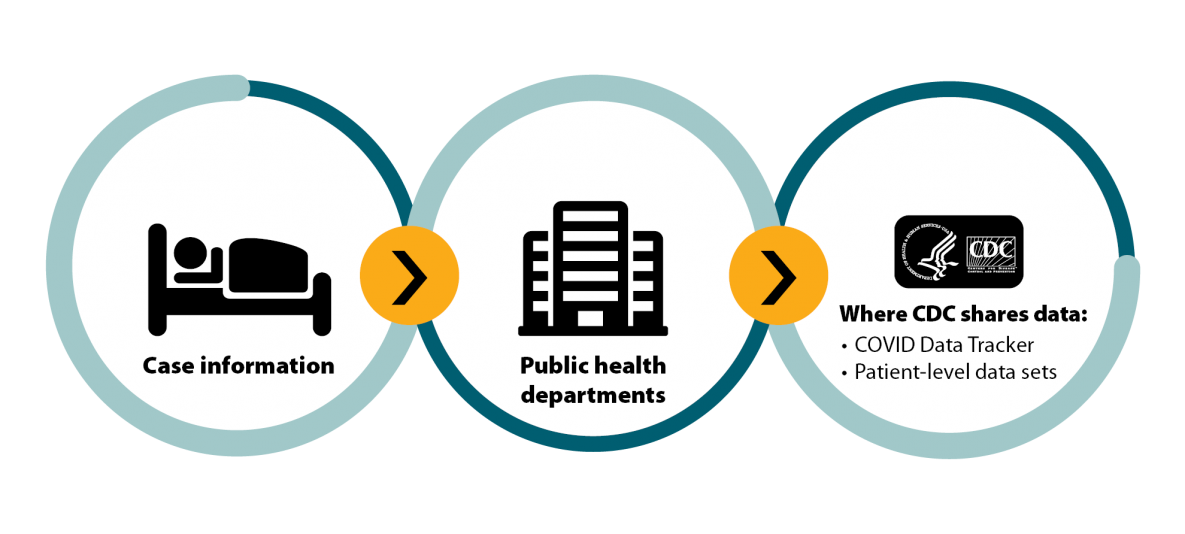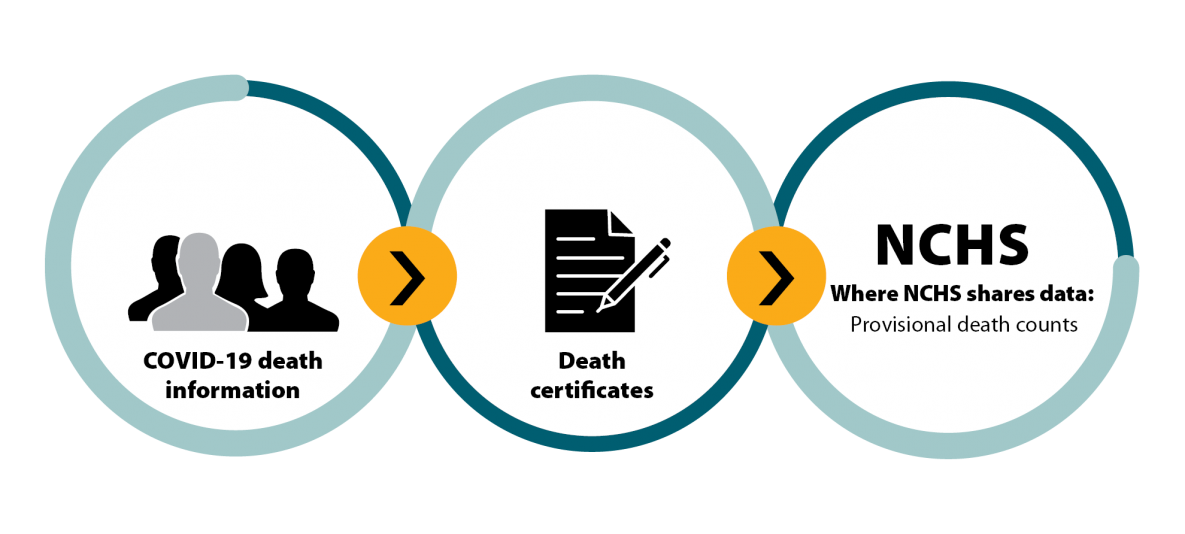Recommendations for Fully Vaccinated People
COVID-19 Homepage
About CDC COVID-19 Data
CDC reports COVID-19 cases and deaths online in multiple locations, including the COVID Data Tracker, through provisional death counts, and in patient-level data sets. Sharing timely and accurate information with the public is a core activity of the emergency response. It helps us track disease-related trends, detect outbreaks, and determine whether public health actions are working. Much of the information shared by CDC is based on reporting from jurisdictions. Accurate and timely reporting from jurisdictions drives this process.
Data Sources
Information about COVID-19 cases comes from the following three key sources:

Aggregate Count Data
Description: Aggregate count data provide case and death totals, reported through 60 U.S.-affiliated jurisdictions, at the state and county level. Aggregate counts can be compiled quickly, and they are the most current. (Read on for more about reporting jurisdictions.)
Source: CDC collects this information through a robust process that includes a review of jurisdictional websites. Public health jurisdictions also report and validate data as part of the process.
Where to find it: CDC shares aggregate counts in COVID Data Tracker.

Patient-Level Data
Description: Patient-level data, which are also known as line-level data, provide information for each COVID-19 case. Patients are never identified, but important information such as age, race, and ethnicity is often included. Reporting can lag because the information is detailed, and it can take longer to collect.
Source: Line-level data is based on reporting from states, territories, and other jurisdictions.
Where to find it: CDC shares line-level data in COVID Data Tracker, as well as in patient-level data sets that are made available to the public for research.
Learn more about the process for collecting aggregate and line-level data at FAQ: COVID-19 Data and Surveillance.

Death Counts
Description: Information about deaths from COVID-19.
Source: Death certificates provide the most accurate counts, but, the data collection process takes longer. Due to the lag time, numbers can initially be lower than in other published sources.
Where to find it: CDC’s National Center for Health Statistics (NCHS) provides mortality data through provisional death counts.
You can download data source information as an infographic [PDF – 100 KB] to print, save, or share.
Accuracy of Data
COVID-19 is one of about 120 diseases and conditions that must be reported to state, local, and territorial health departments. This process helps officials identify outbreaks and control the spread of disease. Health departments voluntarily report case information to CDC, which compiles and publicly shares data related to COVID-19 illnesses, hospitalizations, and deaths.
While CDC strives to provide complete and accurate data, there are a few challenges. First, COVID-19 can cause mild illness, and symptoms might not appear immediately. This can lead to delays in testing and reporting. Also, not every infected person will get tested or seek medical care, especially if symptoms are not present. Finally, there are differences in how states and territories report cases. The number of new cases reported each day can fluctuate, and reporting frequency can vary by jurisdiction. Health departments may also update case data over time as they receive more complete information.
For these reasons, there might be discrepancies between numbers reported by CDC versus by health departments. When this occurs, data reported by health departments should be considered the most accurate.
Aggregate Count Data
There are currently 60 U.S.-affiliated jurisdictions reporting COVID-19 case and death data to CDC. This includes the following:
- The 50 states
- The District of Columbia
- New York City (which is not included in New York State’s reported case and death counts)
- The U.S. territories of American Samoa, Guam, the Commonwealth of the Northern Mariana Islands, Puerto Rico, and the U.S Virgin Islands
- Three independent countries in compacts of free association with the United States (Federated States of Micronesia, Republic of the Marshall Islands, and Republic of Palau)
In addition to COVID Data Tracker, aggregate count data are available in data.cdc.gov.
Patient-Level Data
Publicly available datasets are critical for open government, transparency, and research. They also support efficiency by offering the same data and information to the public, media, and others while maintaining individual confidentiality. CDC has three COVID-19 case surveillance patient-level datasets available:
COVID-19 Case Surveillance Public Use Data with Geography: Public use, patient-level dataset with clinical and symptom data, demographics, and state and county of residence. This dataset contains 19 data elements.
COVID-19 Case Surveillance Public Use Data: Public use, patient-level dataset with demographic and clinical information, including symptoms. No geographic data is available. This dataset contains 12 data elements.
COVID-19 Case Surveillance Restricted Access Detailed Data: Restricted access, patient-level dataset with demographic and clinical data, including symptoms. Geographic data (state and county of residence) is available. Access requires a registration process and a data-use agreement. This dataset contains 33 data elements.
About the public use and restricted access databases:
- Data elements are available for review on the COVID-19 case report form.
- All data is provisional and subject to change until reconciled and verified.
- Some data are suppressed to protect individuals’ privacy.
- Cases are listed by the earliest date available in each record. This could be the date received by CDC or the date related to illness/specimen collection.
- There is a 14-day lag before CDC shares datasets to ensure accuracy of time-dependent outcome data.
- Datasets are updated every two weeks.
Datasets comply with CDC’s Policy on Public Health Research and Nonresearch Data Management and Access. Access all three COVID-19 datasets at data.cdc.gov. Direct dataset questions to Ask SRRG at eocevent394@cdc.gov.
Death Counts
CDC reports death counts in the following areas of our website. All data are provisional and subject to change.
- COVID Data Tracker, which serves as CDC’s home for COVID-19 data, offers information about U.S. cases and deaths. Timely and accurate reporting at the jurisdictional level drives this process. Reporting frequency varies, so counts might increase at different rates.
- Provisional death counts are provided through NCHS. These reports come from death certificates, which offer information from physicians, medical examiners, and coroners. The death counts here are the most accurate, but it takes longer to collect the information. There is an average lag time of one to two weeks, which might cause discrepancies from counts on other published sources. NCHS explains more about how this works in Understanding the Numbers.
For questions about how COVID-19 cases and deaths are defined, please review FAQ: COVID-19 Data and Surveillance.
Additional Resources
- For more information about public health reporting, visit How We Conduct Case Surveillance.
- Access additional COVID-19 resources, such as wastewater surveillance data, at COVID-19 Data Sources.
- Learn about the vaccination data collection process at Reporting COVID-19 Vaccinations in the United States.
- Access Addressing Gaps in Public Health Reporting of Race and Ethnicity for COVID-19 [PDF, 2.3 MB, 31 pages], a report from the Council of State and Territorial Epidemiologists to better understand the challenges in completing race and ethnicity data for COVID-19 and recommendations for improvement.